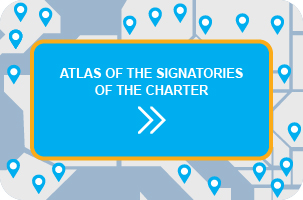CEMR and Gender Equality
Since 1983, the Council of European Municipalities and Regions (CEMR) works actively to promote equality between women and men in the decision-making process.
The structuring of the action of CEMR’s women elected representatives
In 1983, two hundred women representatives of European municipalities, provinces and regions met on the occasion of the first “Meeting of women local and regional elected representatives of the European Community” organised by CEMR in order to allow for the debating of the “Renewal of European Society” over a period of three days.
By emphasizing the principle according to which local and regional authorities have a primordial role to play in ensuring a balanced development of the European Community, women elected representatives insisted on three points: the participation of European women in local and regional assemblies, the actions carried out by the European Institutions to promote equal opportunities and the impact of Community policy on local and regional authorities.
The second meeting, in 1986 was held in Saint Jacques de Compostelle, a city that was chosen since the women representatives’ desired to take action by standing by their Spanish and Portuguese counterparts at the time of their countries’ joining the European Community. Several subjects of concern fostered their discussions: for example, supporting the Community’s 1986-1990 programme in favour of equal opportunities and the need for actions vis-à-vis the governments in view of the adoption of new directives relating to the equal treatment of men and women in their professional lives. The women elected representatives also requested that the Community, in its transformation into the European Union, incorporate the principle of equal opportunities for men and women into the new Treaty on European Union.
The British Delegation, with the support of two key women in CEMR’s actions for equality, Baroness Farrington of Ribbleton and Doreen Fleming, submitted a resolution providing for the creation of a structure within CEMR which would allow for the monitoring and the support of the policies of the European Communities’ Commission as well as the actions of the European Parliament’s Commission on Women’s Rights in favour of equality.
More than 150 women local and regional elected representatives met in Antwerp in 1988, on the occasion of the third meeting organised under the theme “the responses of European local and regional authorities faced with the challenges of contemporary society”. Women representatives also highlighted, as was the custom at these meetings, local problems, in particularly violence in the cities, the integration of migrant women and initiatives aimed at youth.
The 4th meeting in Heidelberg in 1992, was above all significant in light of the creation of the standing CEMR Committee of women elected representatives of local and regional authorities with the mission to increase the presence of women in politics and to promote their role in European construction. Through this committee, women representatives from different European countries have the opportunity to discuss their respective national situations, to exchange their experiences in view of transferring best practices in terms of equality and to monitor the evolution of European policies in this area.
The launching of actions aimed at Central and Eastern Europe
In the beginning of the 1990s, the members of CEMR’s Committee of women elected representatives of local and regional authorities placed importance on the need to establish contacts with the women elected representatives of the Central and Eastern European countries in view of their future membership in the EU. The different meetings organised between 1994 and 1998 played a decisive role in opening this dialogue.
The Dublin Conference in 1995 was a pivotal step for the women local and regional elected representatives of CEMR. The conference coincided with the setting up of the Committee of the Regions, a European representative body of local and regional authorities, instituted by the Maastricht Treaty. The women elected representatives of CEMR worked hard to raise the awareness of the members of this institution with regard to the question of respect for equal opportunities. Following an ad hoc resolution, a working group was created. This working group drew up recommendations aiming to strengthen the presence of women within the national delegations of the Committee of the Regions named by the governments, as well as to ensure a monitoring of the dimension of equal opportunities in the opinions adopted by this institution.
Creation of a European network of women elected representatives of local and regional authorities
At the 20th General Assembly of European Municipalities and Regions in Thessaloniki in May.
1996, CEMR’s Committee of women elected representatives launched a European Network of women local and regional elected representatives in order to improve the exchange of information and best practice in favour of equality at local level in Europe.
This network, made up of nearly 1600 women elected representatives from 34 European countries set up information tools for elected representatives on local level, organised seminars on “the presence of women in local politics”, in view of the local elections taking place in the host countries a research on the presence of women in politics, particularly at local level in different EU countries, was also conducted. This research enabled, for the first time, specific data to be assembled on women’s participation in local politics in Europe.
At occasion of the Executive Bureau meeting held in Sintra in 2000, a resolution was adopted; recommending that a regular evaluation be undertaken on the application of the principle of the equality of men and women within CEMR, its national associations and member local and regional authorities.
At the 21st General Assembly of European Municipalities and Regions in Oulu in 2000, local and regional representatives approved a strategic action plan for governance and equality which constituted a genuine framework for achieving a balanced representation of men and women within local and regional authorities, the CEMR member national associations and the governing bodies of the organisation.
European and International inroads
The turn of the century brought to light CEMR’s political commitment in favour of equality on the international scene. In June 2000, a CEMR delegation of women local and regional elected representatives participated in the Beijing+5 Conference organised by the United Nations in co-operation with IULA. The European women local and regional elected representatives were able to share their experiences of local life in Europe with their counterparts from all over the world and speak of the results achieved in this area as well as persisting barriers.
Five years after the World Conference on Women in Beijing, at which time a Platform for Action for the development of the status of women was launched, the New York Conference provided the opportunity to assess the progress accomplished since then. The theme of the 23rd Special Session of the United Nations General Assembly was therefore “Women 2000: gender equality, development and peace for the twentyfirst century”. At the close of this event, the role of local authorities was recognised in the action plan for the implementation of Beijing+5.
From “The town for Equality” to the European Charter for Equality of women and men in local life
The objective of “The town for equality” was to depict, with the help of CEMR’s network, a virtual portrait of a town that takes gender equality into account in all of its policies. The results of the project, which led to the organisation of several seminars involving elected representatives, local officials and representatives from civil society, were published in the “The Town for Equality, a guide of methodology taking into account the best practices in Europe on this subject. Once town for equality was virtually established, local and regional authorities were encouraged to take a step in this direction through a political commitment. “The European Charter for the equality of women and men in local life” was the resulting project.
For further information: 25 years of actions towards equality in Europe
Current work
The CEMR Standing Committee for Equality and the expert group on gender equality prepared a gender equality position paper and action plan (adopted in June 2018) to guide the work of the Observatory of the 2018-2020 period.
“Local equality: Going the distance to achieve gender equality” is available for download here.















